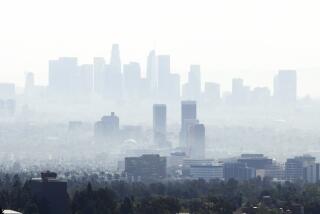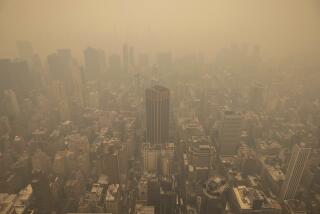Airborne Allergies
- Share via
Allergy sufferers, brace yourselves. It’s likely to be a long, rough road ahead.
This year’s record rainfall has created good growing conditions for mold and pollen-releasing plants, both major sources of hay fever. Allergy sufferers will feel the effects, and so will many people who have previously been spared the sneezing, congestion and itchy eyes.
“We’re heading for the worst allergy year L.A. has seen in a long time,” said Dr. Jacob Offenberger, an allergist who practices in North Hollywood and Granada Hills.
Those with seasonal allergies should expect to have symptoms longer than usual this year.
“People who are typically bothered for a month can now expect one and a half times longer,” said Dr. Hrair Koutnouyan, an ear, nose and throat specialist in Glendale. Getting a head start on antihistamines and topical nasal steroids before the person’s allergy season hits can help reduce the body’s response, he said.
Here are some tips to help ease the misery of allergies:
Outside the home
Pollen
To reproduce, all plants need pollen, the microscopic, dust-like powder produced by the male parts of the plant. Plants with large, brightly colored flowers are pollenated by bees. Others depend on the wind to spread their pollen, which is inhaled and sometimes causes allergic reactions. And Santa Ana winds make it worse.
Plants pollenate in a certain order throughout the year: trees, grasses, weeds, and in the West, pollen seasons tend to last longer than in the rest of the country. The good news: Rainy days reduce pollen allergy symptoms because the particles get washed away. The bad news: Mold growth increases after a rainy spell.
Trees: Pollination from late January through April in California.
* Most troublesome for allergy-sufferers in the Valley: olive, oak, walnut, mulberry, ash and Chinese elm.
* Less troublesome: dogwood, pear, pine, plum, palm, redwood, ginkgo, red bud, magnolia, tulip tree.
Grasses: Pollination from March through November in California, peaking in May throug July.
* Most troublesome for allergy-sufferers in the Valley: timothy, Bermuda, orchard.
* Less troublesome: rye, dichondra, Irish moss, Saint Augustine.
Weeds: Pollination from May to October in California, peaking in August.
* Most troublesome for allergy-suffers in the Valley: sage, lamb’s quarter, English plantain, western ragweed, Russian thistle (tumbleweed).
Outdoor molds: Grow on damp surfaces such as plants, damp firewood, compost piles, standing water and dirt. Growth spurt following a rain storm.
How to reduce symptoms:
* Keep windows and doors closed and use an air conditioner, especially on windy days and between 5 and 10 a.m.
* If you don’t have air conditioning, try putting an ordinary furnace filter in your window, instead of a screen
* Consider installing an electrostatic filter in furnace to trap pollen grains
* Shower and wash your hair, especially before going to bed
* Rinse contact lenses with saline to get rid of pollen
* Limit trips outside
* Wear facemask when doing yard work
* See a doctor for treatment and advice, which might include prescription drugs and/or immunotherapy (allergy shots)
Pollen and mold counts
The amount of pollen and mold spore in the air is measured by a machine called a Rotorod, which spins a greased rod in the air for one minute each hour. Every 24 hours, the rod is stained with a colored dye and the pollen and mold spores on the rod are counted under a microscope. Counts made available to the public are generally a day or two old and therefore are only an indicator of how recentweather affected one’s allergies. However, tracking pollen counts and weather trends can help allergy sufferers minimize their symptoms.
* For local pollen and mold counts: Asthma and Allergy Foundation of America, Los Angeles chapter: (800) 624-0044
* For nationwide pollen and mold counts: National Allergy Bureau at (800) 9-POLLEN
Inside the home
There are several indoor creatures and conditions that can trigger hay fever (known by the medical term of allergic rhinitis) and asthma.
Dust mites: Microscopic, insect-like creatures found mattresses, pillows, blankets, curtains, carpets and upholstered furniture. They thrive in humid and warm conditions and on skin scales shed from humans. Mite droppings are the main substance in house dust that cause people allergic symptoms.
* Wash bedding weekly in hot water (130 degrees)
* Encase mattress, box spring and pillows in dust-proof covering
* Remove carpeting in bedroom; vacuum often
* Replace Venetian blinds with easy-to-clean shades
Profile of a dust mite
(dermatophagoides pteronyssinus)
* Family: Arachnid (eight-legged creatures which includes spiders, chiggers and ticks)
* Reproduction: Female mites lay 25 to 30 eggs; new generation produced every three weeks
* Life cycle: about 30 days
* Preferred climate: temperatures above 70 degrees with relative humidity at 75 to 80%. Mites die when humidity falls below 40 to 50%. Rarely found in very dry climates
* Volume: Up to 18,875 can live in one gram of dust, but usually there are 100 to 500 mites per gram. (About the weight of a paper clip.)
* Waste matter: Mites produce 10 to 20 waste particles each day, the main part of house dust that trigger allergies
Indoor molds: Grow year-round, depending on the humidity inside the house, on damp surfaces such as shower stalls, rotting floors and windowsills. Houses thathave experienced severe flooding are likely to have mold growing in the walls.
* Increase ventilation in kitchen and bathroom
* Clean surfaces weekly with a weak solution of chlorine bleach
* Obtain a gauge to measure humidity inside house
* Use a dehumidifier or air conditioner to keep humidity level below 40%
* Remove excess humidity as a result of showering or cooking with an exhaust
Pets: dander, urine and saliva accumulate in dust throughout the house
* Keep offending pets outside (if possible) or at least keep them out of the bedroom.
* Wash pets weekly
* Have a non-allergic family member brush pet outside; also have them clean its litter box or cage.
* Air cleaners may help eliminate some of the pet dander and allergens.
* Immunotherapy (allergy shots) can improve but not completely prevent allergic symptoms, and can have severe side effects. Shots work best when person has only occasional, unavoidable exposure.
* If allergy is bad, consider getting tropical fish, turtles snakes or any animal that doesn’t have hair
Cockroaches: dead roaches and droppings accumulate in house dust
* Clean house regularly
* Use commercial road control methods
Is it an allergy or a cold?
Before you can begin to treat the symptoms, you’ve got to know what you’re dealing with. Allergies and the common cold have similar symptoms, but different causes. If you experience symptoms of either, contact your doctor for a diagnosis and treatment plan. This chart helps differentiate between allergies and the common cold.
ALLERGY
1) Symptoms present during...particular seasons or year-round
2) General symptoms last...untreated, longer than two weeks
3) Symptoms include...congestion, itchy eyes and nose, sneezing attacks
4) Nasal secretion: watery and thin
5) Treatment option: many effective treatments
COLDS
1) Symptoms present during...year-round but mainly September through May
2) General symptoms last...five to seven days, may linger for two weeks
3) Symptoms include...congested or runny nose, sore throat, coughing, sneezing, muscle pain, fever
4) Nasal secretion yellow and thick
5) Treatment option: many remedies, few methods proven to work
Allergies by the numbers
* An estimated 50 to 60 million Americans--about on eof every five adults and chldren--suffer from allergies, including allergic asthma.
* Allergies are the sixth leading cause of chronic disease in the United States.
* Allergies are responsible for 3.4 million lost U.S. work days each year, at a cost of $639 million.
* U.S. consumers and employers spend as much as $2 billion each year on allergy treatment, including office visits, tests, medications and immunotherapy (allergy shots).
* More than 22 million Americans have hay fever (allergic rhinitis).
* An estimated 6 to 10 million Americans are allergic to cats.
Allergies and kids
* Hay fever (allergic rhinitis) is the most frequently reported chronic condition in children.
* An estimated 2 million school days are lost each year due to allergies.
Allergy Calendar
January
San Francisco Bay Area: Trees
Southern California: Trees
*
February
San Francisco Bay Area: Trees
Southern California: Trees
*
March
San Francisco Bay Area: Trees, Grass
Southern California: Grass
*
April
San Francisco Bay Area: Trees, Grass
Southern California: Grass
*
May
San Francisco Bay Area: Trees, Grass
Southern California: Grass
*
June
San Francisco Bay Area: Trees, Grass
Southern California: Grass
*
July
San Francisco Bay Area: Ragweed, Grass
Southern California: Ragweed, Grass
*
August
San Francisco Bay Area: Ragweed, Grass
Southern California: Ragweed, Grass
*
September
San Francisco Bay Area: Ragweed
Southern California: Ragweed, Grass
*
October
San Francisco Bay Area: Ragweed
Southern California: Ragweed, Grass
*
November
San Francisco Bay Area: Ragweed
Southern California: Grass
*
December
San Francisco Bay Area: None
Southern California: None
How allergens affect the body
The term “allergy” refers to an inappropriate or exaggerated response of one’s immune system. During an allergic reaction, symptoms may affect only certain parts of the body: skin, upper airways, eyes or stomach and intestines. In some allergic reactions, especially those to unjected drugs, insect venom or some foods, several organs can be affected simultaneously. Reactions include asthma, hay fever, hives, eczema and even life-threatening anaphylactic shock.
Allergens are introduced to the body in three ways:
Food intake
Breathed
Direct skin contact
1. Allergens enter the body and begin to sensitize the body’s immune system.
2. Lymphocytes, blood cells that form part of the immune system, produce specific antobodies to the allergen.
3. Antibodies attach to mast cells located in the skin and lining of the stomach, lungs and upper respiratory airways, which contain granules of histamine.
4. When the allergen enters the body again, it binds to the antibodies and causes histamine and other chemicals to be released, triggering an allergic reaction.
***
For more information, check out these Web sites:
https://www.aaaai.org (American Academy of Allergy Asthma & Immunology
https://allergy.mcg.edu (American College of Allergy, Asthma & Immunology)
***
Sources: Asthma & Allergy Foundation of America, Los Angeles Chapter; American Lung Assn.; Glaxo Wellcome Inc.; American College of Allergy, Asthma & Immunology; Dr. Jacob Offenberger; Dr. Hrair Koutnouyan; Dr. Bernard Geller; Researched by STEPHANIE STASSEL/Los Angeles Times


